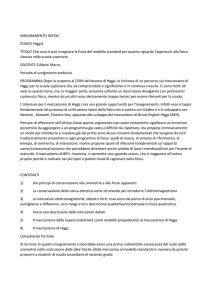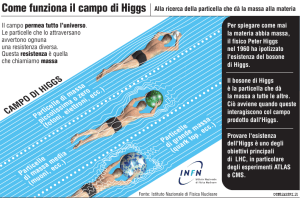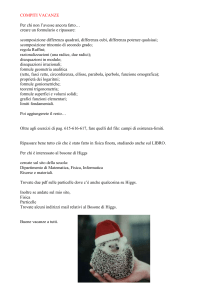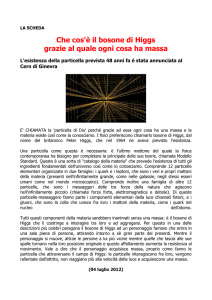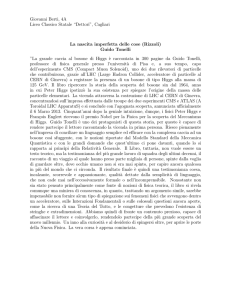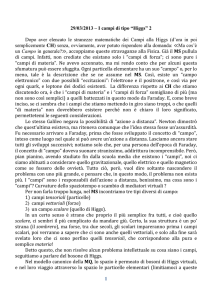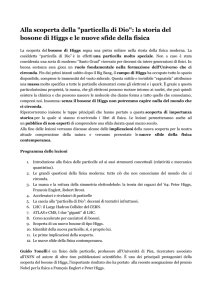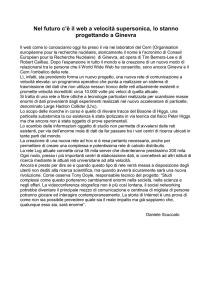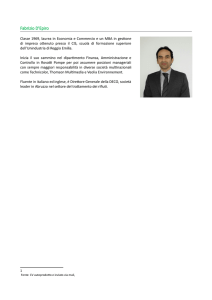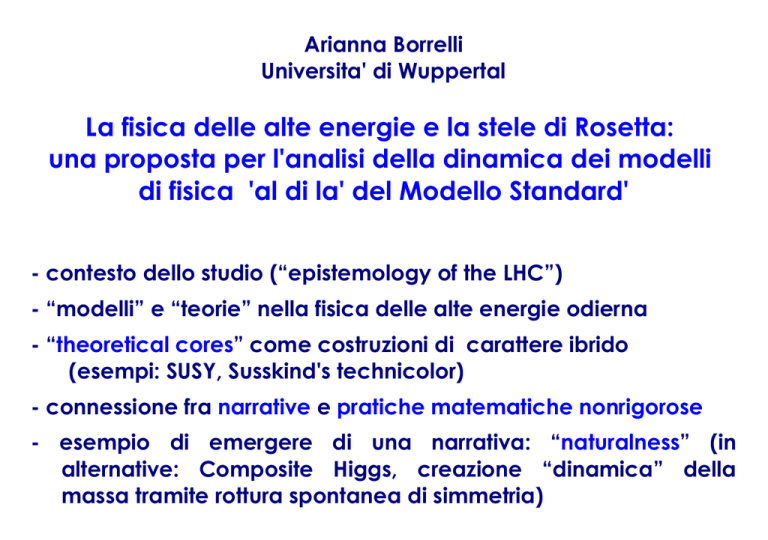
Arianna Borrelli
Universita' di Wuppertal
La fisica delle alte energie e la stele di Rosetta:
una proposta per l'analisi della dinamica dei modelli
di fisica 'al di la' del Modello Standard'
- contesto dello studio (“epistemology of the LHC”)
- “modelli” e “teorie” nella fisica delle alte energie odierna
- “theoretical cores” come costruzioni di carattere ibrido
(esempi: SUSY, Susskind's technicolor)
- connessione fra narrative e pratiche matematiche nonrigorose
- esempio di emergere di una narrativa: “naturalness” (in
alternative: Composite Higgs, creazione “dinamica” della
massa tramite rottura spontanea di simmetria)
"Epistemology of the LHC"
und "project cluster" dells DFG
Universita' die Wuppertal (Germania)
Tre progetti:
• The epistemic dynamics of model
development at the LHC
• LHC-experiments between theoryladenness and exploration
• An epistemological and ontological
study of the Higgs mechanism
Partecipanti:
Arianna Borrelli ▪ Simon Friederich▪ Robert Harlander ▪ Koray Karaca
Dennis Lehmkuhl ▪ Peter Mättig ▪ Gregor Schiemann ▪ Erhard Scholz ▪
Christian Zeitnitz ▪ Michael Krämer (Aachen) ▪ Holger Lyre (Magdeburg)
Friedrich Steinle (Berlin) ▪ Michael Stöltzner (S. Carolina)
Progetto "epistemic dynamics of model development at LHC"
oggetto: modelli di fisica "beyond the Standard Model" (BSM)
obiettivi iniziali dello studio (inizio 2010):
(1) ricostruzione del panorama di modelli e classificazione
(2) quali criteri vengono addotti da scienziati che lavorano su
uno o l'altro dei modelli per giustificare la scelta?
(3) modifiche di panorama e criteri sulla base di risultati LHC
Metodologia: analisi preprint, interviste, survey online
Primi risultati (2010/2011):
(1) situazione complessa - "cluster" di modelli e intersezioni
(2) gli stessi motivi vengono citati per diversi cluster/modelli
(3) poche modifiche (almeno fino al fine 2012)
Lo studio dei preprint mostra che lo sviluppo dei modelli BSM
continua a seguire le tendenze dei decenni precedenti
---> Analisi storico filosofica dell'emergere di un particolare
"cluster" (composite Higgs/technicolor) allo scopo di ricostruire
le caratteristiche generali della dinamica
Domanda preliminare: con che tipo di oggetti abbiamo a che
fare? modelli o teorie?
La distinzione fra modelli e teorie in campo filosofico e' un tema
molto dibattuto
---> come approccio filosofico di riferimento si e' deciso di
utilizzare l'idea di "models as mediators" (Morgan/Morrison), che
presenta grande flessibilita' - non si e' cercato pero' di applicare
tale approccio in tutti i dettagli, ma nell'idea generale:
"models mediate between theories and the world"
--> modelli BSM = "models" ---> e le "teorie" e il "mondo"?
Modelli BSM: clusters di modelli ragguppati attorno a idee centrali:
- modelli con piu' di un bosone di Higgs
- supersimmetria
-dynamical symmetry breaking (technicolor, composite Higgs..)
- extra-dimensions
- Higgs as pseudo-Goldstone boson
- ....
● i cluster hanno vita lunga, i singoli modelli hanno vita breve
● i modelli possono combinare elementi di diversi cluster
● i modelli devono essere in grado di riprodurre i fenomeni del
Modello Standard (o almeno non contraddirne le previsioni)
---> il "mondo" e' rappresentato dal Modello Standard, che e' il
punto di riferimento "empirico" di tutti i modelli
---> il livello teorico e' rappresentato dai cluster, che pero' non
sono teorie nel senso classico del termine (costruzioni
matematiche coerenti), ma hanno carattere ibrido
I modelli BSM mediano fra il Modello Standard e "theoretical cores"
che comprendono:
- strutture matematiche (e.g. trasfomazioni SUSY, metodo di rottura
della supersimmetria, "warped metrics"...)
- "empirical references" (simili agli exemplars di Kuhn, Pickering):
analogie con altre aree della fisica (specialmente stato solido)
in cui strutture matematiche simili a quelle del "core" hanno
trovato riscontro empirico (e.g. predizione di nuove particelle
sulla base di simmetrie approssimative (quarks, neutrini..) <-->
predizione di "superpartners" per particelle esistenti)
- narrative che connettono i vari elementi di cui sopra. Le narrative
sono espresse per lo piu' verbalmente, ma inglobano gli altri
componenti (e.g. "esiste in natura una supersimmetria che lega
bosoni e fermioni, ma che e' rotta in maniera 'soffice', cosicche'
i partner delle particelle note hanno masse elevate")
Gli elementi di un "theoretical core" vengono implementati piu' o
meno elaboratamente nei singoli modelli, che pero' non sono visti
primariamente come "semi" die future teorie, ma piuttosto come
strumenti esplorativi per conoscere le proprieta' dei core (e.g.
diversi tipi di SUSY-breaking portano a spetttri di masse
qualitativamente diversi) - il modello come "stele di Rosetta":
---> non e' importante cose esattamente c'e' "scritto" ne modello,
ma piuttosto se alcune specifiche "parole e frasi" appaiono
promettenti per interpretare il linguaggio della natura:
“You might say that we are all searching for the language of the
universe. But whereas string theorists focus on the inner logic of
the grammar, model builders focus on the nouns and phrases
that they think are most useful. If particle physicists were in
Florence learning Italian, the model builders would know how to
ask for lodging and acquire the vocabulary that would be
essential to finding their way around, but they might talk funny
and never fully comprehend the 'Inferno' "(Randall, 2006)
1979 - Leonard Susskind „Dynamics of spontaneous symmetry breaking in
the Weinberg-Salam model“ - Susskind combina elementi gia' presenti in
di altri autori, ma li unisce tramite una narrativa molto convincente
narrativa: il bosone di Higgs che rompe spontaneamente la simmetria
elettrodebole non e' una particella elementare, ma un composito die
fermioni ancora non osservati che hanno interazioni analoght a quelle
dei quarks (sia nella forma tipo QCD che nell'intensita')
elementi matematici: teoria delle interazioni forti con struttura anloga alla
QCD
„empirical references“:
superconduttivita'
pion/quarks <---> Higgs/“nuovi fermioni“
N. B. solo recentemente il modello dei quark era stato accettato come
una rappresentazione di realta' elementari (scaling violations)
Susskind sottolinea nella scelta del linguaggio l'analogia con la QCD
(„heavy-quarks, “„heavy-color“ piu' tardi „techniquarks, “„technicolor“) e
costruisce modelli esplorativi - di cui pero' nessuno e' realistico
Connessione fra narrative e pratiche matematiche nonrigorose
Tesi: il ruolo di elementi narrativi nella ricerca teorica diviene tanto piu'
importante quanto piu'
1 - i concetti fisici sono essenzialmente definiti sulla base di costruzioni
matematiche (“perdita di intuitivita'/ Anschaulichkeit” ?)
2 - le costruzioni matematiche utilizzate nella ricerca hanno carattere
nonrigorso (rinormalizzazione, gruppo di rinormalizzazione ecc.
Conseguenze:
- tensione fra matematici e fisici, emergenza di nuovi “theoretical
objects”, che non sono “ne' fisici ne' matematici” (Galison 2004 sulla
teoria delle stringhe, ma applicabile anche a modelli BSM)
- utilizzo di strategie narrative come guida nel model-building
1993-94: Morris W. Hirsch (topologo) sul dibattito Jaffe/Quinn:
"While sloppy proofs are all too common, deliberate presentation of
unproven results as correct is fortunately rare.
Much more frequent is the use of mathematics for narrative
purposes. An author with a story to tell feels it can be expressed
most clearly in mathematical language. In oder to tell it coherently
without the possible infinite delay rigor might require, the author
intoduces certain assumptions, speculations and leaps of faith [...]
The result of the narrative will be not new mathematics, but a new
description of "reality" (real reality!). This use of mathematics can be
shocking to the pure mathematician encountering it for the first
time; but it is not only harmless, but indispensable to scientists and
engineers."
una narrativa ibrida che combina elementi matematici e non
("assumptions, speculations, leaps of faith") porta ad una nuova
descrizione della realta' e in questo viene accettata come equivalente ad
una narrazione matematica rigorosa che si assume esistere, ma non
essere (per ora) accessibile
1972-1979: Successo empirico del Modello Standard (MS)
- eppure crescone le speculazioni su una "nuova fisica"
1979: L. Susskind "sostiene che il MS e' "unnatural" - perche'?
- as energia P = 10 exp(19) GeV ("Scala di Planck") il MS non
vale piu' per via di effetti gravitazionali (assunzione non
problematica)
- ne segue (secondo Susskind) che tutte le sommatorie sulla
variabile energia da 0 ad infinito dovrebbero essere sostituite
con sommatorie da 0 a P !
- in particolare, per la massa M del bosone di Higgs segue:
M = Costante (1─10 exp(-38))
→ un aggiustamento alla 38esima cifra decimale → "unnatural"!
L'argomento di Susskind ha vari "buchi" (Weinberg, Veltman...)
1.perche' P dovrebbe essere limite di tutte le sommatorie?
2.tutte le Formule sono imprecise
3.l'aggiustamento non crea problemi fisici (rinormalizzazione)
....ma si tratta di una narrativa convincente che avra' successo
Nuove formulazioni matematiche della "naturalness" come la
proprieta' die una teoria che non richiede "aggiustamenti"
't Hooft (1980): "Naturalness" come "dogma": un parametro fisico A
puo' essere piccolo rispetto alla scala energetica della teoria
sole se per A=0 la simmetria del sistema cresce
Veltman (1981): un tentativo di dare una formulazione rigorosa dell
"invalidita'" del MS ad alte energie, e di definire cosi' la
"naturalness" in maniera rigorosa ("misura" di naturalness)
Le varie formulazioni mathematiche vengono presto considerate
come diverse indicazioni di uno stesso fatto: l' esistenza di und
"nuova fisica" al di la' del modello standard. a partire dal 1980: iviene costruito un numero sempre crescente
die teorie di "nova fisica" con la motivazione die risolvere il
problema della "naturalness" (supersymmetria, Technicolor,
large extra dimensions, warped extra dimensions, gauge-Higgs
unification)
da ca. 1981: "unnatural" ist anche MHIGGS << Planck-Skala
("hierarchy problem")
----> anche le differenze delle masse delle particelle, se non
derivate da un principio, possono essere interpretate come un
segno die "unnaturalness"
Conclusione:
• La narrativa della "naturalness" e' una sola, ma con varianti
• Il problema della "naturalness" viene caratterizzato come
"filosofico", "estetico"...
• ..ma e' una fondamentale motivazione di ricerca
• fa parte della "shared knowledge" della comunita' HEP
• viene visto come problema sia da teorici che da sperimentali
• La narrative appare molto spesso nell'apertura di articoli
Due versioni della narrativa una teorica e una sperimentale
TH: "Fine tuning appears in many areas of particle physics and
cosmology, such as the standard model hierarchy problem and
the cosmological constant problem. These problems imply that the
Universe we live in is a very atypical scenario of the theories we
use to describe it. The contortion required to reproduce observation
makes such theories seem unnatural, motivating many studies of
beyond the standard model (BSM) physics." (Athron/Miller 2007)
EXP: "The hierarchy problem is the huge gap, 17 orders of
magnitude, between two fundamental scales of physics: the
electroweak scale and the Planck gravity scale. One of the
consequences is that, if no new physics exists between these two
scales, then the Higgs mass diverges, unless it is unnaturally finetuned. New physics to stabilize it is already needed at the TeV
scale, a well-known problem that has motivated the construction of
the LHC and has been addressed by several theories beyond the
SM." (F. Gianotti 2006)
Alternativa 1 - "composite Higgs"
1958-59 - BCS theory of superconductivity: the symmetry puzzle
electromagnetism (+QM) vs.
electrons, nuclei
gauge symm. + charge cons.
BCS theory
quasiparticles
no gauge symm., no charge cons.
BUT: quasiparticles --(nonpert. effects)--> „collective excitations“
---> gauge symmetry and charge conservation recovered!
1960 - Nambu uses methods of QFT to reformulate BCS theory:
(a) [symm. equation --(nonpert. effects)-->nonsymm. solution (quasipart.)]
--(nonpert. effects)--> collective excitations (of quasiparticles)
(b) story: collective excitations as consequence of (hidden) symmetry
1961 - Nambu+Jona Lasinio: behind strong interactions is a similar „story“
[symmetric equation --(nonpert. effects)--> massive nucleons]
--(nonpert. effects)--> pions (as nucleon composites)
٭massive nucleons & pions linked to symmetry „lost and recovered“
٭short-lived models are built as a feasability demonstration
1961
Goldstone black-boxes the nonperturbative effects into an elementary
scalar field representing the „collective excitations“
- his explorative model will be the seed of the Higgs field
1962
Baker and Glashow frame the story anew as „spontaneous symmetry
breaking“ - a good name for a good story
1964-1976
rise of Weinberg/Salam model: EWSB through a Higgs field
„generates“ masses
quark model as a formal tool to understand strong interactions
---> Nambu-Jona Lasinio (NJL) model with quarks as heuristic tool
1974-1976
EWSB through NJL-like mechanism discussed, but little interest
1976-1979
quarks & their dynamics (QCD) as „real“ theory of strong interactions
----> hadrons (e.g. pions) regarded as really quark composites
1979
Leonard Susskind „Dynamics of spontaneous symmetry breaking in
the Weinberg-Salam model“: various elements previously isolated
resonate to form a new theoretical core:
story: the Higgs boson spontaneously breaking EW-symmetry is not
elementary, but a composite of as-yet-unobserved fermions with
interactions analogous to those of quarks (i.e. QCD-like)
mathematics: pion as result of spontaneous symmetry breaking of
quark interactions (NJL); formalism of QCD
empirical references:
superconductivity (old)
pion/quarks <---> Higgs/“new fermions“ (new!)
only now can quarks provide a convincing empirical reference
Susskind argues for his approach by underscoring the analogy to QCD
(„heavy-quarks, “„heavy-color“ later „techniquarks, “„technicolor“) and
by building explorative models - none of which was realistic
- yet his approach was an immediate success.....
The further life of a theoretical core
1979-1990
flow of new models: technicolor, extended technicolor, supercolor,
hypercolor, ultracolor, then walking technicolor (new core-elment!)
1990-1995
unfavourable results from LEP, but walking technicolor walks on
large mass of top quark ----> „topcolor“ (Higgs as top-composite)
- another new core element....
...and model-building goes on...
„Technicolor, topcolor, and related models provide an avenue for
constructing theories in which electroweak symmetry breaking has
a dynamical origin. Unfortunately, no complete and consistent
model of this type exists. “
(S. Chivukula, Avenues for dynamical symmetry breaking, 1999)
The failure of a model is not the failure of its core - only an indication
of a new „avenue“ for developing the elements in the core further....
Alternativa 2 - Narrativa die generazione di massa
Mid 1950's: QED established, but lots of new particles found!
J. Schwinger “A theory of the fundametal interactions” AP (1957)
"This note is an account of some developments in an effort to find a
description of the present stock of elementary particles within the
framework of the theory of quantized fields. [...] We shall attempt to
describe the massive, strongly interacting particles by means of fields
with the smallest spin appropriate to the statistics, 0 and 1/2 [evtl. 1]. We
suppose that the various intrinsic degrees of freedom are dynamically
exhibited by specific interactions, each with its characteristic symmetry
properties, and that the final effect of interactions with successively lower
symmetry is to produce a spectrum of physically distinct particles from
initially degenerate states [...] dynamical origin of mass"
dynamical ~ properties of theory after/through renormalization
dynamical properties are due to an “unknown physical agency”
- but: in the paper only the Lagrangian level is discussed!
Fields: Ψ (n, p ...), Φ(1) (π-mesons), Φ(0) (hypoth. σ-meson)
The scalar field Φ(0) (σ-meson) has a special role:
“The unique properties of the σ-field [...]: As a field which is scalar under
all operations [...] Φ(0) has a nonvanishing expectation value in the
vacuum [and so] a suitable [fermion] mass constant might emerge”
when Φ(0) → Φ(0) – µ/g then gΦΨΨ → gΦΨΨ – µΨΨ
weak interactions? triplet: photon + 2 charged vector bosons ...
“we again use the Φ(0) field to remove three-dimensional internal
symmetries and produce mass for charged particles”
Schwinger's idea are taken up by many authors....
1960: Gell-Mann&Levy's σ-model: Schwinger's σ-field construct is
used to produce partial conservation of weak axial current:
“The fact that the σ coupling is responsible for the nucleon mass is a
curious property of the model. Unless we can explain all masses, or at
least all baryon masses, in a similar way, it is not very satisfactory”
1959-1961: Salam&Ward build upon Schwinger's idea
- photon + 2 charged vector bosons are EW-gauge bosons
- the σ-field breaks the gauge symmetry with its VEV
- .... giving mass to the charged gauge bosons
all statements are only backed up by discussions at the level of the
Lagrangian (no “dynamical” computations), but the connection to
dynamical mass generation is strongly stated
In the meantime: Heisenberg & collaborators (1958ff.)
Key idea: symmetric theory of non-linear spinor interactions
---(nonperturbative effects)---> variety of particle phenomena
the "symmetry reduction" is due to a asymmetrical vacuum state asymmetrical solution to symmetric equations:
“the asymmetrical ground level is not properly a vacuum, but rather a
“world” state which constitutes the basis for the existence of elementary
particles”
the vacuum acts as an "infinite reservoire" of quantum numbers
However, Heisenberg was never able to construct a
phenomenologically satisfactory model, but his ideas found some
support in solid-state-physics
1961 - Nambu&Jona Lasinio
Analogy: superconductivity ↔ strong interactions
Theory of superconductivity (1958-60: BCS, quasi-particles):
- based on electromagnetic interactions...
- ...but apparently no EM-gauge symmetry!
superconducting states are nonperturbative, asymmetrical
solutions of the symmetric equations of electromagnetism
electrons, nuclei
↔ hypoth. massless fermions (Heisenberg!)
quasi-particles
↔ massive nucleons
collective excitations ↔ pions (bound states of nucleons)
Some (sketchy) nonperturbative computations are given:
"perturbative vacuum" vs. "nonperturbative vacuum"
"The two worlds are physically distinct and outside of each other.
Nevertheless, even in a particular world we can find manifestations of
the invariance [e.g. neutron masses]"
1961 Salam: Nambu's model as a possibility to implement the
symmetry breaking between electromagnetic and weak
interactions in the Salam/Ward proposal
1961 Goldstone: non-perturbative effects are black-boxed in a
(Goldstone) boson to study their consequences:
“The models [...] all have a boson field in them from the beginning. It
would be more desirable to construct bosons out of fermions”
Goldstone's scalar field has a “double-well” potential and its
VEV gives rise to different asymmetrical minima/vacua, but:
“A method for losing symmetry is of course highly desirable in
elementary particle theory but these theories will not do this without
introducing non-existent massless bosons”
1962: Goldstone, Salam & Weinberg: Further arguments in favours
of the “Goldstone theorem”: the σ-field is no good for
producing mass “dynamically”, but nonperturbative effects
may still be a path....
1962 Baker&Glashow "Spontaneous breakdown of elementary particle
symmetries“ through nonperturbative effects
“Should not the complexities of the phenomena of elementary particle physics
arise from a “simple” fundamental theory? Such a possibility was discussed by
Heisenberg and co-workers [...] It is conceivable that the field equations may
be highly symmetric expressions, while their solutions may reflect the
asymmetries of nature. This is the philosophy we adopt in this paper [...] We
propose that a nonperturbative behaviour characterizes all the interactions to
which elementary particles are subject. Mass is completely dynamical; mass
splittings and 'approximate symmetries' result from nonsymmetric solutions to a
fully symmetric Lagrangian theory [Conclusion:] we have shown the possibility
that the fundamental interactions can generate themselves from a 'bootstrap
mechanism' in a theory where the bare coupling constants vanish"
1962 Schwinger "Gauge invariance and mass"
“[T]he essential point [of the computation] is embodied in the view that the
observed physical world is the outcome of the dynamical play among
underlying primary fields, and the relationship between these fundamental
fields and the phenomenological particles can be comparatively remote, in
contrast to the immediate correlation that is commonly assumed”
1964-66: Brout, Englert, Guralnik, Hagen, Higgs, Kibble black-box
nonperturbative effects in Goldstone's scalar field, but as a
manifestation of deeper, unexplored structure of nature, e.g.:
“The idea that the apparently approximate nature of the internal
symmetries of elementary particle physics is the result of asymmetries
in the stable solutions of exactly symmetric dynamical equations,
rather than an indication of asymmetry in the dynamical equations
themselves, is an attractive one. Within the framework of quantum field
theory such as a “spontaneous” breakdown of symmetry occurs if a
Lagrangian, fully invariant under the internal symmetry group, has such
a structure that the physical vacuum is a member of a set of (physically
equivalent) states which transform according to a nontrivial
representation of the group. [...] That vacuum expectation values of
scalar fields, or “vacuons,” might play such a role in the breaking of
symmetries was first noted by Schwinger and by Salam and Ward”
(Higgs 1966)
...their results support the idea that the scalar field is “special”...
...and this idea was motivation for the (indipendent) proposals of
Weinberg and Salam (1967-68) that the scalar field might
gurarantee renormalizability to their unified electroweak theory:
Salam (1968): "[masses are introduced] more gently than a brutal
addition and subtraction of mass terms [...] letting the vector mesons
interact with a set of scalar particles and let them acquire physical masses
by assuming self-consistently that these scalar particles possess nonzero
vacuum expectation values"
Weinberg (1967) “Is this model renormalizable? We usually do not
expect so, but [our vector bosons] get their mass from the spontaneous
breaking of the symmetry, not from a mass term put in at the beginning"
No mathematical argument for renormalizability, but belief that the
scalar represents a “gentle”, “spontaneous” way to give mass
The proof will be delivered in 1971 by Gerhard 't Hooft using
techniques developed by Benjamin Lee and others to renormalise
the σ-model....
...but that is another story!

